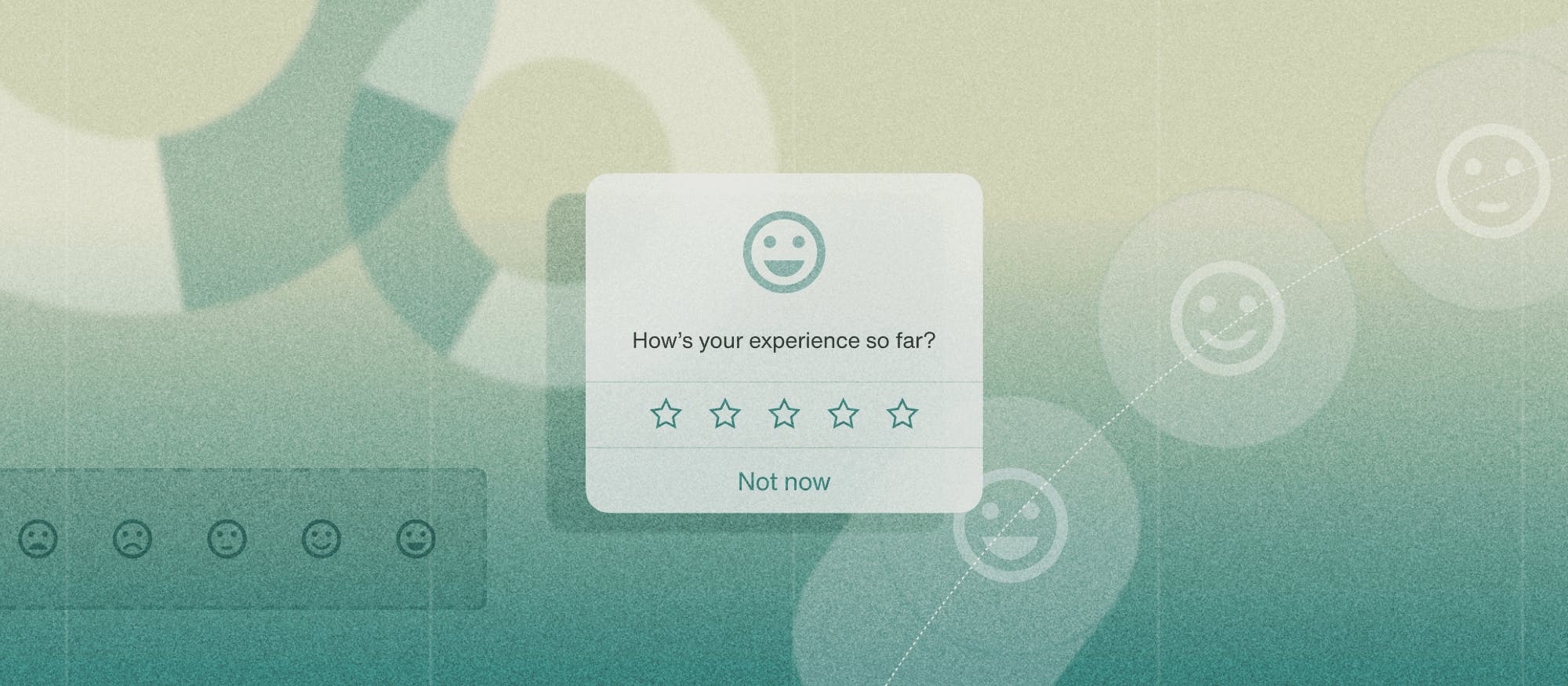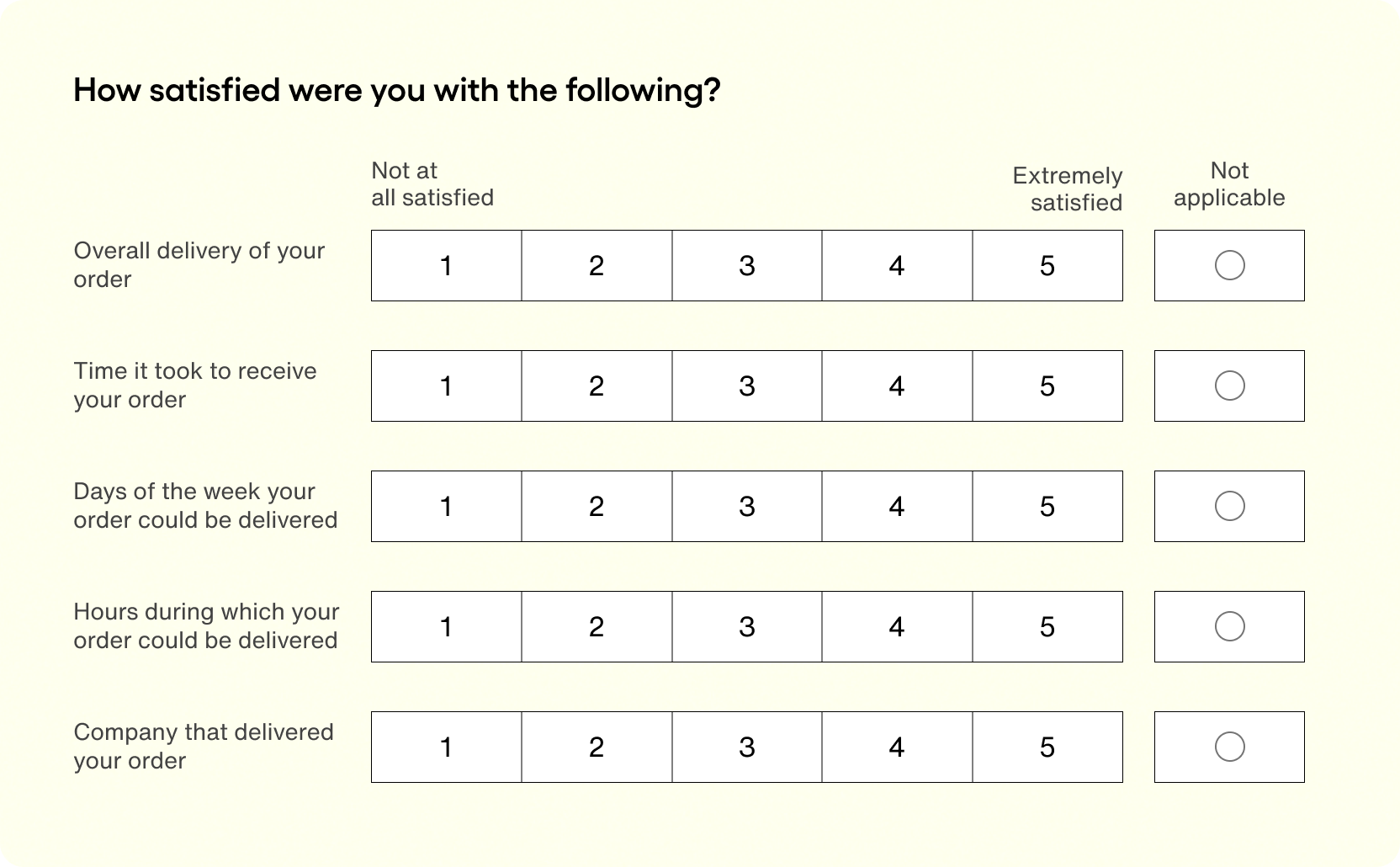14 steps to improve your CSAT score

Maintaining customer satisfaction is crucial for the success of any business. At a glance, here are 14 ways to improve CSAT and have a competitive advantage in the market:
Measure your current CSAT and set goals
Ask the right questions
Deliver omnichannel support
Maintain your brand voice at every touchpoint
Adopt asynchronous in-app support
Maintain personalization
Listen and act on customer feedback
Build a support relationship recovery program
Weave customers into your culture
Build a QA process
Reduce response times with automation
Provide a self-service option
Satisfied employees create satisfied customers
Solutions > excuses
The stats show that retaining customers is much more cost-effective than finding new ones — and happy customers often become devoted advocates.
For this reason, improving CSAT (customer satisfaction) scores should be a top priority for every company. But how exactly can you drive customer satisfaction in the right direction?
In our work, we have seen how brands can turn around their CSAT scores with a few key adjustments.
To help you achieve the same kind of transformation, we used our insights to create a recipe for CSAT success. Keep reading to discover the secret ingredients.
What is CSAT score?
Before we dive into the action plan, it’s a good idea to understand the challenge here.
CSAT is short for customer satisfaction score. This metric helps you track how your customers feel after interacting with your business — such as making a purchase or seeking customer support.
In most industries, the average CSAT score is somewhere in the 70–80% range.

Achieving a score above 80% is obviously better than falling below this benchmark. But even if you have a healthy CSAT score, it’s worth trying to push it higher.

Virgin Mobile UAE improved their CSAT with Sendbird Desk.
How to calculate CSAT
In order to calculate your CSAT score, you first need to collect some data.
CSAT surveys are usually quite simple, asking customers to rate their recent experience on a scale of 1–10. Your score is the percentage of respondents who give you an overall positive rating (7–10).
This isn’t the only way to come up with a figure. You can use emoji-based surveys to break customers into three groups (happy, neutral, unhappy) or use a scale of 1–5, where ratings of 4 and 5 are regarded as positive.

Other customer satisfaction metrics
CSAT isn’t the only method for measuring how your customers feel. Here are some other customer satisfaction metrics to pay attention to:
Net promoter score (NPS) — Similar to CSAT, but focuses on long-term satisfaction with your brand or product.
Customer effort score (CES) — This metric asks users to rate the level of difficulty involved with using your product or service.
Customer retention rate (CRR) — In simple terms, what percentage of customers are sticking with you over a period of time?
Customer churn rate (CCR) — On the flip side, how many customers are leaving?
Tracking multiple metrics and KPIs can help you build a more complete picture of satisfaction levels throughout your business.

8 major support hassles solved with AI agents
Why is improving customer satisfaction important for your business?
While customer satisfaction might seem like a “fluffy” topic, the truth is that CSAT scores are often closely linked to the bottom line. In fact, this metric is an excellent health indicator for your business.
Here are some of the key benefits that usually come with improved customer satisfaction scores:
Better customer loyalty
According to multiple studies, the cost of acquiring new customers is five times higher than earning sales from your existing customers.
To unlock that repeat business, you need to satisfy your clients or users. Research shows a clear link between customer satisfaction and customer loyalty.
Push your CSAT scores upwards, and you’re more likely to have buyers coming back for more.
Building a community is a good way of achieving this. By providing a social space where customers can interact between themselves and with your brand, you encourage a greater sense of ownership.
Increased customer lifetime value
A positive side-effect of improving customer retention is usually an increase in customer lifetime value (CLV).
This metric measures the amount of revenue you generate from each customer, on average, over the course of your business relationship.
By keeping your customers happy, you’re likely to extend these connections over a longer period. And just as importantly, you have a better chance of selling upgrades to returning buyers.
Reduce customer churn
What’s the opposite of customer loyalty? Churn.
If you can consistently meet customer expectations, you’re going to lose fewer of those customers over time. Reduced churn usually means a more consistent flow of revenue. It also reduces the pressure on your marketing and sales departments to come up with a constant stream of new leads.
Churn is particularly important for digital businesses, because users are notoriously fickle. In a competitive environment, providing good customer service is often the best way to prevent people jumping ship.
Improve brand perception
The way each customer feels about your business is largely dependent on their satisfaction levels. This matters both on an individual level, and in terms of your overall brand.
Whether customers are happy or displeased, they are likely to share their feelings with others — contributing to a narrative about your brand. These perceptions can spread quickly, and they can be difficult to change once they set root.
The best way of ensuring that perceptions are positive is by improving your overall customer satisfaction levels.

Delight customers with AI customer service
The 14 steps in your CSAT improvement action plan
Customer satisfaction is influenced by a range of factors — including your product and your pricing. These are fundamental pillars of your business that are difficult to change.
However, you can still improve the overall customer experience you provide by making adjustments to your support and marketing strategies.
To guide you through this process, we have created a comprehensive action plan. Here’s how to unlock better customer satisfaction in seven easy steps:
1. Measure your current CSAT and set goals
Before embarking on any major project in business, it’s always a good idea to take stock.
Sending out detailed CSAT surveys will help you to gauge the mood among your customers right now, and evaluate the performance of your customer service teams. This data will provide a reference point for any future improvements.
As such, it’s worth collecting plenty of customer feedback. Be sure to ask about every step of the customer journey, from initial contact through to after-sales support.
Along with measuring your CSAT, this data can provide insights through other metrics. If you’re not already tracking NPS (Net Promoter Score) and CES (Customer Effort Score), we highly recommend that you start doing so.
Put together, these metrics are really your key performance indicators.

Boost CSAT with proactive AI customer service
2. Ask the right questions
Although the CSAT metric was designed to measure how your customers feel, your score can be influenced by other factors. Perhaps the most prominent one is the content of your customer satisfaction surveys.
In particular, survey questions can play a pivotal role in shaping the responses you receive.
When you’re composing your survey, try to:
Only ask questions that serve a specific purpose
Use clear language that everyone will understand
Avoid asking leading questions (i.e. ask people for their opinion rather than asking them to agree with your own statement)
Ask for ratings rather than binary answers
Stick with these principles, and you should certainly see better quality data — and possibly a higher score.

3. Deliver omnichannel support
Once you have baseline numbers to work with, it’s time to start making some changes. If you don’t already offer omnichannel customer support, this should be your first priority.
You see, how you provide support is a big factor in customer satisfaction. People want to be able to get help when they need it, and through the channels that are most convenient for them.
While pushing all support requests through a single channel might seem convenient from a business perspective, you’re unlikely to deliver a great customer service experience this way.
Instead, we would recommend offering a mix of contact channels. The blend could include:
In-app support
Email
Social media
Phone
If that sounds like a headache, bear in mind that your support team can handle requests from multiple channels in real-time using software like Sendbird Desk.
This platform even allows you to set up chatbots, enabling more self-service support and reducing your response times to zero.
4. Maintain your brand voice at every touch point
When customer interactions happen across multiple channels, the overall experience can end up feeling a bit disjointed. That’s why your next action point should be setting a consistent brand voice.
Your brand voice is essentially the character of your business. It could be fun and light-hearted, or very serious and professional. But what really matters most is that you’re consistent. You want your brand to come across as likable and trustworthy, not weird and unpredictable.
To make this happen, we recommend working on three key areas:
Communication with customers — If your contact center and marketing department can maintain a consistent tone of voice, you’re more likely to deliver the kind of reliable service that customers crave
Design and user experience — Maintaining a consistent look across all channels will give customers more confidence in your professionalism, and help them to navigate your support systems
Continuity in support — When someone asks for help via live chat, they shouldn’t have to repeat the whole query when they later contact you via email or social media
Getting everything perfectly lined up may take some time, but you can speed up the process by building comprehensive guidelines for tone of voice and design within your company.
5. Adopt asynchronous in-app support
If your business has a presence on mobile platforms, it’s a good idea to adopt asynchronous in-app messaging as one of your primary support channels.
Unlike live chat, asynchronous support does not require a real-time connection between the customer and your support team. Conversations continue naturally when the user has time, and when you have the bandwidth to provide assistance. When you don’t, chatbots can reduce wait times.
Asynchronous messaging is also more familiar for most people. After all, it’s the same style of communication we use every day in apps such as Messenger, WhatsApp, and Telegram.
Of course, you could use these third-party platforms to provide support. However, keeping users in your app allows you to maintain full control over customer data and analytics provide that continuity of service we talked about earlier.
With Sendbird Chat, you can implement asynchronous messaging via our powerful API, and customize the support experience for your customers.
6. Maintain personalization
As a general rule, customers love personalization. Any service that is shaped to individual needs is always going to be more convenient to use, and personalized offers tend to be more relevant.
What’s more, personalized messaging makes us feel more valued — a bit like the local barista who knows you by name. When you add these factors together, you’re almost guaranteed to see an improved CSAT score.
The stats back this up. Research by McKinsey found that 71% of consumers expect companies to deliver personalized interactions, and 76% of respondents are annoyed when their experience isn’t personalized.
In other words, introducing personalization to your product should be a top priority if you care about CSAT.
If possible, you should also try to make the personalization seamless — such as being able to put down a conversation on one platform and pick up the thread elsewhere. You can add this feature to your app or website quite easily with Sendbird.

Reimagine customer service with AI agents
7. Listen and act on customer feedback
While it’s worth taking some proactive steps to boost customer satisfaction, it’s simply not possible to reach a high CSAT score without listening to your customers and acting on what you hear.
There are many different ways to collect customer feedback — from face-to-face interviews and focus groups to digital surveys and even online review sites.
Whichever method you choose, what matters most is that you focus on the negative feedback.
Sure, some of the worst survey responses may hurt your ego. But these reviews can give you valuable insights into the mind of your unhappiest customers. If you can fix their pain points, you will be well on the way to a record CSAT score.
8. Build a support relationship recovery program
Unless your CSAT is close to perfect, you probably have a few less-than-satisfied customers. Some might have had a single bad experience; others may have felt their frustrations growing over time.
Either way, you need to win back their approval if you’re going to ramp up your customer satisfaction levels.
In our experience, the best way of achieving this is through a service recovery program. This should provide a clear action plan for re-engaging with a client when something goes wrong.
The plan should define:
Who gets in touch with unhappy customers — It’s often a good idea to escalate issues and get a support manager involved
How they should approach the conversation — As a general rule, you should apologize, ask questions to understand why the customer is unhappy, create an action item to fix the problem, and then follow up
What records you keep on these events — Making a note of incidents helps you learn valuable lessons, and tracking the number of events over time helps you figure out whether you’re making progress
9. Weave customers into your culture
In order to effect any major change in business, you really need to go beyond protocols and guidelines. These are merely signposts that guide your staff along your desired path. But the direction of travel comes from your culture — both in terms of the company, and your team of individuals.
As such, the businesses that really excel in customer satisfaction tend to be those with a customer-centric mindset.
Although it’s important to keep the bottom line in sharp focus, putting an emphasis on customer needs gives you a better chance of achieving your financial goals in the long term.
In fact, looking after loyal customers and first-time buyers alike is one of the best ways to drive new growth in your existing business.
10. Build a QA process
A product that doesn’t work properly is always going to receive low-end CSAT scores.
In some cases, this is as a result of poor design and engineering. But even if you have a really well-designed product, bugs and defects can easily ruin the overall user experience.
For example: push notifications might not seem that important. But when users are relying on updates from your app, reliable delivery really matters.
This is why having a quality assurance process is really important if you want to maximize your CSAT score.
Before you release new updates, make sure to run thorough tests on all major features and your interface. If you don’t have the knowledge or resources in house, outsource the testing process to QA specialists.
11. Reduce response times with automation
Customer support is often one of the key battlegrounds for CSAT.
You can have the most extensive knowledge base in the world, but some of your users are going to need help. When they reach out, they don’t want to spend three hours trying to get through to a call center, or wait half a week for an email reply.
In fact, HubSpot found that 90% of consumers regard an immediate response to support requests as “important” or “very important.”
This is where automation can really help. Creating a chatbot allows users to begin the process of seeking help, and to feel like they are making progress — even when all your agents are busy.
AI chatbots further elevate the support experience, allowing customers to engage immediately in human-like conversations while they wait for live agents.
Meanwhile, the AI chatbot can start to gather information about the customer issue. This means that by the time a member of your support team is available, they should be able to solve the issue faster.
To learn more, you can read our introductory blog to what is an AI chatbot?

Automate customer service with AI agents
12. Provide a self-service option
While it’s important to provide live help, most users want to fix problems themselves. What’s more, 77% of customers actually view brands in a more positive light when they provide self-service options.
There are several ways to supply this kind of support. Creating a thorough knowledge base is a good starting point. If you include a community element, users can even help each other with more niche issues.
For the most common support requests, like refunds and returns, a simple self-service help center should do the trick. Automating these tasks should massively increase the amount of time your support team has for real problems.
You could also think about setting up a chatbot. This technology allows customers to interact with your knowledge base and automated tools within a familiar, conversational interface. Thanks to AI, chatbots are now more capable than ever — and they are really easy to install.
13. Satisfied employees create satisfied customers
While tactical measures can move your CSAT score in a positive direction, you really need to take a more holistic approach if you want to maximize customer satisfaction and reap the rewards.
A good place to start applying this mindset is behind the scenes, within your support team. Agents who are feeling the pressure are generally less likely to provide the kind of service that customers expect. People are perceptive, and even the smallest hint of stress in the way someone speaks can come across badly.
To avoid these issues, try to create a good working environment for your support team. Give them tools that work efficiently, and access to the information they need. As we mentioned before, using automation can reduce the overall burden placed on your agents.
In turn, your staff should be better placed to deliver the kind of friendly, patient service that every customer wants.
14. Solutions > excuses

As part of your holistic approach, it’s important to look at an under-par CSAT score as an opportunity for improvement, rather than something to explain away.
Self-reflection is the key here. What could you be doing better? If you find yourself out of ideas, try to research the reasons why people give you a specific rating. This could be through your original survey, or through a follow-up questionnaire or interview.
When you listen to the personal experiences of your customers, the path ahead becomes clear: you simply need to address any problems they mention.
Improve customer satisfaction with Sendbird Chat API
Whether you operate in the tech space or simply want to provide a better customer experience through your digital channels, Sendbird can help.
Our Chat API helps you to implement feature-rich asynchronous messaging and support in any app, with translation and moderation built in. Deliver a consistent brand experience that immerses customers in your brand.
It’s fast, flexible, and fully configurable to your needs.
Sound good? Sign up today to start your free trial, or talk with our sales team to discover how Sendbird Chat can boost your CSAT in weeks.










